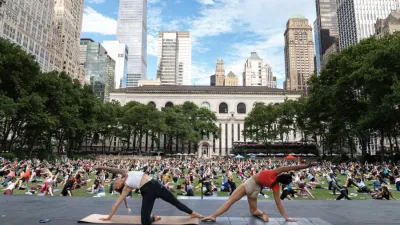The new American Dream will transform cities and towns in the 21st Century. To understand it, we have to grasp a few features of the previous American Dream.

The new American Dream will transform cities and towns in the 21st Century. To understand it, we have to grasp a few features of the previous American Dream, which created the metropolitan regions that we know today. That Dream is still operative — although it has faded a bit since the 2008 housing crash. A Pew study shows the country now evenly split between two visions of the good life.
There were many good parts to the 20th Century American Dream. It provided shelter for three generations of Americans. It delivered a house, a yard, and a car (later two or three cars) to most households. It also tended to separate society by income, reduce community connections through sprawl, and increase automobile and road costs.
The top tier of that American Dream was the McMansion. The front of the McMansion has what is called “curb appeal,” an effect not unlike what the peacock achieves with its feathers. The multiple gables, the big, little-used front lawn, the porch too shallow to sit in — all have little practical function.
Those are status symbols — as is the big, expensive car. You can’t walk anywhere from the McMansion. There’s nowhere to walk to. For the children who grew up in these areas, the shopping mall was the town square.
FULL STORY: Why 'place' is the new American dream

Planetizen Federal Action Tracker
A weekly monitor of how Trump’s orders and actions are impacting planners and planning in America.

Canada vs. Kamala: Whose Liberal Housing Platform Comes Out on Top?
As Canada votes for a new Prime Minister, what can America learn from the leading liberal candidate of its neighbor to the north?

The Five Most-Changed American Cities
A ranking of population change, home values, and jobs highlights the nation’s most dynamic and most stagnant regions.

Op-Ed: Why an Effective Passenger Rail Network Needs Government Involvement
An outdated rail network that privileges freight won’t be fixed by privatizing Amtrak.

‘Quality Work, Fast’: NC Gears up for Homebuilding After Helene, Trying to Avoid Past Pitfalls
The state will field bids to demolish, repair and rebuild homes in the mountains. After struggles in eastern NC, officials aim to chart a different course.

Washington State’s Parking Reform Law Could Unlock ‘Countless’ Acres for New Housing
A law that limits how much parking cities can require for residential amd commercial developments could lead to a construction boom.
Urban Design for Planners 1: Software Tools
This six-course series explores essential urban design concepts using open source software and equips planners with the tools they need to participate fully in the urban design process.
Planning for Universal Design
Learn the tools for implementing Universal Design in planning regulations.
Central Transportation Planning Staff/Boston Region MPO
Heyer Gruel & Associates PA
Institute for Housing and Urban Development Studies (IHS)
City of Grandview
Harvard GSD Executive Education
Regional Transportation Commission of Southern Nevada
Toledo-Lucas County Plan Commissions





























